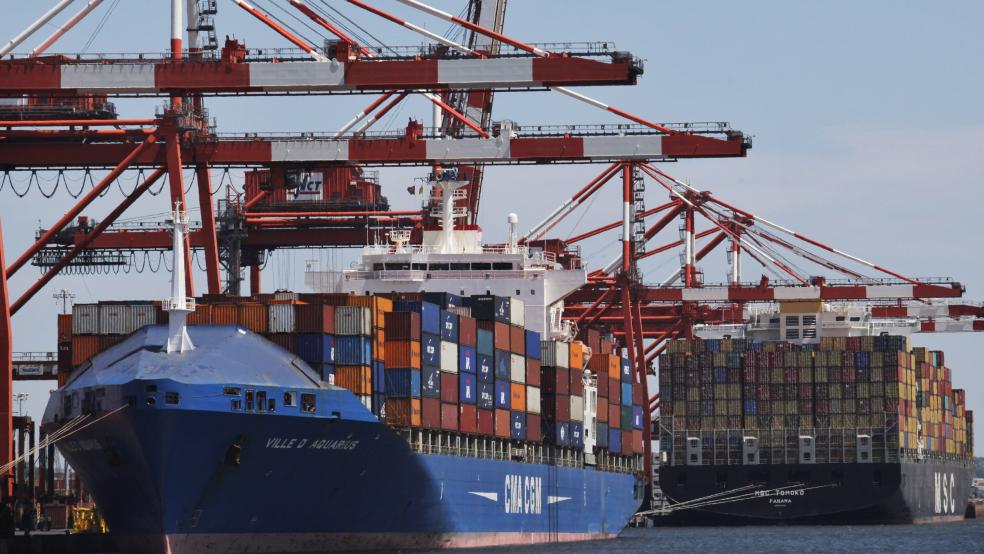This week, 34 large container ships idled outside the nation’s two largest ports, in Los Angeles and Long Beach, California, full of goods that could populate everything from a department store to a 7-11. Combative contract negotiations between longshoremen and management have led to a slowdown at 29 ports on the West Coast, with shipping containers taking up to nine times as long as normal to unload.
Both sides blame each other for lower productivity and the trickle of port traffic; management cites a worker slowdown while labor notes the closure of the ports on nights and weekends. Labor Secretary Thomas Perez, among other luminaries, has joined the negotiations, but there has been no resolution to the impasse.
Most of the commentary about the port problems has focused on the economic cost: $1.9 billion a day, according to Commerce Secretary Penny Pritzker. But the situation reveals something more profound about the fragility of the U.S. supply chain. We simply don’t manufacture enough domestically to satisfy even modest demand, leaving us vulnerable to dangerous supply shocks that aren’t necessarily limited to labor disputes.
Related: U.S. Port Strike Pushes Up Freight Rates
Though the White House has recently talked up a resurgence in U.S. exports, that’s a meaningless statistic without the import side of the equation, like looking at only one side of a baseball box score. When you get the full picture, you find America suffering from a persistent trade deficit, particularly with those countries with whom we have signed free trade agreements (making the recent push for the Trans-Pacific Partnership, which is less about trade than corporate power, look fairly ridiculous).
In 2014, America exported $505 billion less than it imported, a figure that’s even worse if you only look at goods and not services. The country has lost over 5 million manufacturing jobs since NAFTA.
Shipping trillions of dollars’ worth of goods, including a significant amount from China and other low-wage countries in Asia, puts stress on the West Coast ports. There are approximately twice as many goods flowing into those ports as there were during the last work stoppage in 2002, including 70 percent of all imports from Asia.
Even without the labor issues, dealing with this crush of imports can create operational problems in unloading and getting goods into the proper trucks. The labor dispute is “masking some of the longer term issues,” said Dr. Walter Kemmsies, chief economist at Moffatt & Nichol, at a recent Senate hearing on the subject. He cites “increasing concentration of cargo on fewer but larger vessels and in fewer ports” as the main culprit. Because of this, any added disruption, from labor unrest to natural disaster, can have massive ripple effects.
Shippers can re-route to East Coast ports currently operating at full capacity, or try transporting over air. But that just moves the backlog from one place to another, making exporting prohibitively expensive. And in a way that’s beside the point. The fact remains that entire industries, from food to medicine to electronics, rely too heavily on the smooth functioning of a specific supply chain.
Related: The Great American Pilot Shortage
As Matt Stoller pointed out in The Nation four years ago, an earthquake in Taiwan in 1999 ground the computer industry to a halt because factories that made most of the world’s microchips had to shut down. A factory closure in England in 2004 knocked out half of America’s flu vaccine supply. And if anything, tight supply chains have gotten worse since then.
Multinational corporations have outsourced their manufacturing to the countries where they can win the lowest labor costs, and inevitably this concentrates supply lines to the cheapest regions of the world. “Just-in-time” logistics mean that there’s usually no backup for the hyper-efficient supply chain, magnifying the impact of disruptions. Companies have to resort to costly alternatives to transport goods in the event of a supply shock; they don’t build the threats into the process.
If American businesses drain domestic manufacturing know-how and logistical expertise, they increase supply chain vulnerabilities unnecessarily. Industries like retail, which get nearly all their product from overseas, are one missed order away from chaos. And in many ways, that’s the least of our problems — what if the product wrapped up in the supply chain disruption holds the key to stopping a medical pandemic? Or the chemicals we need to keep food preserved?
Even a slowdown, not a shutdown, at West Coast ports reveals the potential consequences. Honda and other automakers announced they would stop production at factories because of parts shortages. The computer industry, still reliant on offshore microchips, currently lacks the components to make PCs. The slowdown has exacerbated the dwindling supply of rock salt, which the East Coast needs this snowy winter. The very chassis that transport goods from the ports into communities have been in short supply recently.
You could argue, as some opinion-makers have, that labor just needs to knuckle under and accept a contract instead of threatening the economy, but this misses the point. While business leaders worry about the bottlenecks that provide opportunities for dockworkers to demand higher wages, they created these bottlenecks by searching far and wide for cheap labor to create their widgets. This realization should lead to “on-shoring” of manufacturing, to remove the supply chain threat. That means investing in jobs at home.
Related: The Real Reason Walmart Is Raising Worker Pay
The port slowdown just provides a low-grade example of what can happen if supply lines get cut or decelerated. The military knows such a scenario provides the best way to collapse an adversary; that’s why they’ve focused on supply chains in the fight against ISIS.
The best way to diversify the supply chain is by keeping at least some factories stateside. It has the added benefit of increasing decent-paying jobs throughout the country, expanding the economy and even improving national security, in the truest meaning of the term. We can be more secure in the knowledge that an unanticipated event thousands of miles away doesn’t have to cripple our everyday life.
Top Reads from The Fiscal Times:




